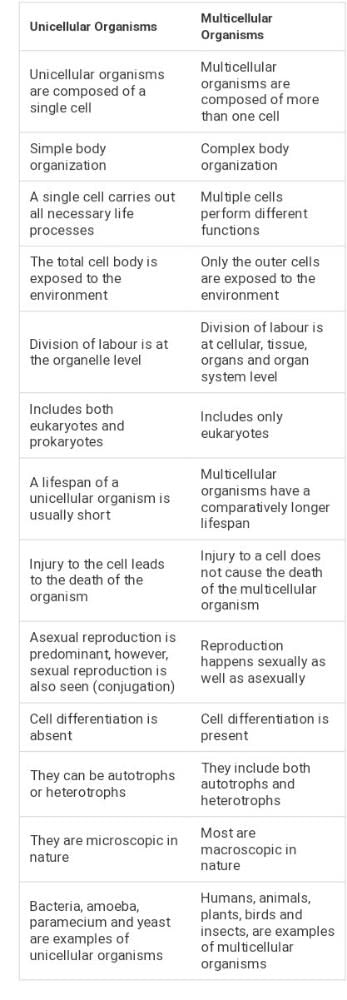Class 9 Exam > Class 9 Questions > Differentiate between unicellular organism an...
Start Learning for Free
Differentiate between unicellular organism and multicellular organism?
Most Upvoted Answer
Differentiate between unicellular organism and multicellular organism?

Community Answer
Differentiate between unicellular organism and multicellular organism?
Unicellular are made of one cell while multicellular organism are made of different cell unicellular organism short lifespan while the multicellular organism have bigger life then unicellular in comparison the unicellular organism death from injuries of the cell while if multicellular organism does not death by injuries of the cell the unicellular organism does the process reproduction by asexual reproduction but in some case's sexual reproduction are also seen but mostly they do the process reproduction by asexual reproduction while the multicellular organism do the process reproduction by sexual reproduction the example of unicellular organism is bacteria , amoeba, paramecium virus ,yeast etc. and in multicellular organism is human, birds, animals, plant insect etc.

|
Explore Courses for Class 9 exam
|

|
Question Description
Differentiate between unicellular organism and multicellular organism? for Class 9 2025 is part of Class 9 preparation. The Question and answers have been prepared according to the Class 9 exam syllabus. Information about Differentiate between unicellular organism and multicellular organism? covers all topics & solutions for Class 9 2025 Exam. Find important definitions, questions, meanings, examples, exercises and tests below for Differentiate between unicellular organism and multicellular organism?.
Differentiate between unicellular organism and multicellular organism? for Class 9 2025 is part of Class 9 preparation. The Question and answers have been prepared according to the Class 9 exam syllabus. Information about Differentiate between unicellular organism and multicellular organism? covers all topics & solutions for Class 9 2025 Exam. Find important definitions, questions, meanings, examples, exercises and tests below for Differentiate between unicellular organism and multicellular organism?.
Solutions for Differentiate between unicellular organism and multicellular organism? in English & in Hindi are available as part of our courses for Class 9.
Download more important topics, notes, lectures and mock test series for Class 9 Exam by signing up for free.
Here you can find the meaning of Differentiate between unicellular organism and multicellular organism? defined & explained in the simplest way possible. Besides giving the explanation of
Differentiate between unicellular organism and multicellular organism?, a detailed solution for Differentiate between unicellular organism and multicellular organism? has been provided alongside types of Differentiate between unicellular organism and multicellular organism? theory, EduRev gives you an
ample number of questions to practice Differentiate between unicellular organism and multicellular organism? tests, examples and also practice Class 9 tests.

|
Explore Courses for Class 9 exam
|

|
Signup for Free!
Signup to see your scores go up within 7 days! Learn & Practice with 1000+ FREE Notes, Videos & Tests.
























